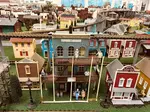 |
Tips on Model Railroad Tracks

Deciding on what type of tracks to use for your layout is one of the more difficult decisions to make when first starting out. There are pros and cons to each brand.
Atlas is probably the most commonly used track because it is generally much more available in local hobby shops than some of the other brands, although Bachmann and Lifelike brands are a close second and third, especially in HO scale or N scale.
Peco and Shinohara brands are favorites among many model railroaders since they appear a little more realistic than the others and they have curved turnouts available which many of the other brands do not.
Bachmann, Piko or LGB are great choices for G Scale track. Lionel is the gold standard for 3-rail O scale track. Atlas and Realtrax are good for 2-rail O Scale. Bachmann and Peco are probably best for On30. HOn30 equipment runs well on any N scale track.
Kato is excellent for N scale, easy to assemble and is very reliable - fewer problems with derailments. Kato in HO scale is also available but a little harder to find. Bachmann EZ Track and Atlas Try Track are also easy to put together, includes the roadbed with the track and are also very reliable for HO or N scale. Unfortunately, there is no flextrack for these easy-connect, roadbed-included tracks. If you do use flextrack to connect to any of these brands with the included roadbed, you will have to put extra roadbed under the flextrack to raise the rails high enough to be flush with the connecting tracks.
I personally like to use flextrack whenever I can because many times the standard sectional track just won't fit where you want it to go, plus it has fewer joints which usually translates to fewer derailments. I like to solder the joints on each side of the flextrack to secure the connections. Also if there are a lot of bends or curves, make sure the flextrack is well-secured to the layout surface to avoid losing the shape that you want for it.
When laying flextrack or other tracks, avoid S-curves unless there is at least one full car length between the curves. If not, this is a setup for derailment.
Try to keep the track code (referring to the vertical height of the rail) the same throughout for your mainline. Code 100 is what I like to use. Branchlines tend to be a little smaller, like code 83, but if you're connecting code 100 with code 83, you will have to use an extra thickness of roadbed under the branchline (code 83) so the tops of the rails coincide where they meet.
The best turnouts to use even on small layouts are the #6 turnouts. #4 turnouts are too short, less realistic and cause more derailments. #8 turnouts take up too much space and are usually not necessary.
Straight parallel tracks should be at least 2 inches apart. Curved parallel tracks should be at least 2 and 1/2 inches apart to avoid railcars side-swiping each other. More if you have longer rail-cars, like auto-carriers and some passenger cars, for example. Test for this using your own rail-cars before attaching the track to your layout permanently.
Curved track should have a radius of no less than 18 inches usually unless you are laying track in a very mountainous area using short locos and railcars. 22-inch-radius curves are usually more realistic and cause fewer derailments.
Remember to have a balance on your layout of scenery, tracks and structures. About a third of your space for each. Try to avoid spaghetti-type layouts, unless that's what you really want.
Don't put tracks any closer than 2-3 inches from your backdrop so there is room for scenery and/or relief of a building. Also, don't put tracks any closer than 2 inches from the edge of your layout or you will be picking up the pieces of your $300.00 locomotives from the floor. Ouch!
(Reprinted with updates and permission from Building Your Model Railroad Hobby Central Train Station)Back to Home Page
Contact Me | Blog | Photos | References | Supplies | GiftShop | Sitemap | Search | Comment | Privacy Statement | Disclosures
Tracks Newsletter: Sign Up Here!
√ = ad or sponsored link
What's New on BYMRR.com?
Recent Articles
-
Model Railroad Supplies
Dec 16, 25 03:46 PM
We have started a new store to help you build your layout and teach your youngsters about science with STEM products. -
DC and/or DCC on the Same Layout
Mar 09, 25 10:46 AM
How to wire your layout for either DC and/or DCC operation. -
Looking for a locomotive speaker
Nov 24, 24 07:29 AM
First Name: Randy E-Mail Address: bymrr@building-your-model-railroad.com Enter your question: : I am looking for a speaker for a Walthers EMD SD70ACE Locomotive, product number 910-9866. The control b…







